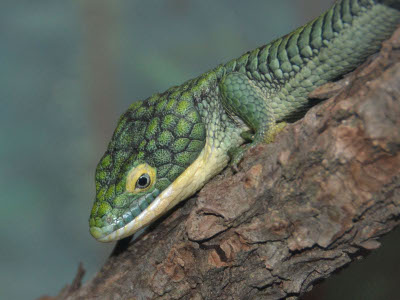Mexican Alligator Lizard
Category: Lizard

Facts about Mexican Alligator Lizard. "Scientific name for Mexican alligator lizard is Abronia graminea". It is an arboreal alligator lizard its on the endangered species list. This species of alligator lizard is endemic to the highlands of Veracruz and adjacent Puebla in Mexico. It is moderately a common lizard, though its population is drastically reducing over the years. It is highly unlikely that the Mexican Alligator Lizards will be found in degraded habitats; they inhabit bromeliads in the cloud forest and the canopy of montane pine-oak.
Mexican alligator lizard Physical Description
There is little information about the species of lizard. The Mexican alligator lizard body length is about 3 to 7 inches (8 to 18 cm) and that is from the snout to the vent, while the tail can measure up to twice its body length. Generally the Mexican Alligator Lizard has a slender snake-like body. It has large head that has quite strong jaws, with a distinct tongue that is slightly fork-shaped. The Mexican alligator lizard has short legs. The skin coloration on the upper side of its body varies widely from gray, to brown, to yellowish with vertical crossbars that have white spots.
Just like the other members of Anguid family, the Mexican Alligator Lizard’s body is covered with bony plates that are overlapping beneath the scales. It has yellow eyes though there are other species that have darker eyes.
It is quite hard to differentiate a male Mexican alligator lizard from a female. Though you can notice that the males heads are somehow wider that their female partners. Overall, the male can not be more than 10% larger than the females. Generally the Mexican Alligator Lizard is quite difficult for one to determine its sex just by casual inspection.
Mexican alligator lizard Characteristics
The scales that are found on its belly are strongly keeled. The Mexican Alligator Lizard has a prominent skin folds that run on either side of its body. These folds allow lungs to expand when the Mexican Alligator Lizard has consumed a large volume of prey.
Its slightly forked tongue aides the lizard to gather the air-borne scents of its prey, the odor is transferred to scent organ placed on its mouth’s roof.
Mexican alligator lizard has the ability to be active in the cool temperatures or the cloudy periods of the day. There is little known about their territorial behavior, but they do inhabit the same site as the Northern Alligator lizards probably they also share the same behavior.
They have a slightly prehensile tail that aides the Mexican Alligator Lizard to climb on trees.
Mexican alligator lizard are the most arboreal alligator lizards around, it has a snake-like undulating pattern formed by its locomotion on the ground. It is also a good swimmer, and uses a serpentine style of swimming rather than the dog-paddle.
When attacked the Mexican Alligator Lizard can easily loose its tail, the wiggling tail causes confusion to the predator and gives it time to get away. If it is caught it will bite strongly and can defecate on the predator.
Mexican alligator lizard Diet/Feeding
The Mexican Alligator Lizards are carnivorous in nature and they feed on a variety of prey, they are non-selective anything they can catch and swallow is definitely on their menu. This includes most insects and their larvae mostly the grasshoppers, ichneumon wasps, ground beetles, scorpions, centipedes, spiders, snails, tadpoles. Breeding is believed to take place between May to June. The female Mexican Alligator Lizard gives birth to between 3 and 14 live young following a gestation period of 8 to 12 weeks

 Back To Category Lizard
Back To Category Lizard